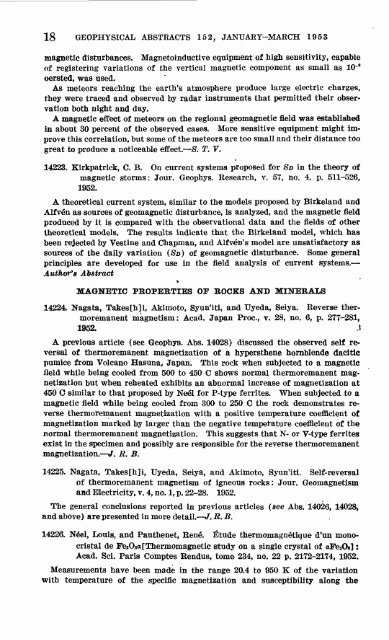Geophysical Abstracts 152 January-March 1953
Geophysical Abstracts 152 January-March 1953
Geophysical Abstracts 152 January-March 1953
Create successful ePaper yourself
Turn your PDF publications into a flip-book with our unique Google optimized e-Paper software.
18 GEOPHYSICAL ABSTRACTS <strong>152</strong>, JANUARY-MARCH <strong>1953</strong><br />
magnetic disturbances. Magnetoinductive equipment of high sensitivity, capable<br />
of registering variations of the vertical magnetic component as small as 10~8<br />
oersted, was used.<br />
As meteors reaching the earth's atmosphere produce large electric charges,<br />
they were traced and observed by radar instruments that permitted their obser<br />
vation both night and day.<br />
A magnetic effect of meteors on the regional geomagnetic field was established<br />
in about 30 percent of the observed cases. More sensitive equipment might im<br />
prove this correlation, but some of the meteors are too small and their distance too<br />
great to produce a noticeable effect. S. T. V.<br />
14223. Kirkpatrick, C. B. On current systems proposed for 80 in the theory of<br />
magnetic storms: Jour. Geophys. Research, v. 57, no. 4, p. 511-526,<br />
1952.<br />
A theoretical current system, similar to the models proposed by Birkeland and<br />
Alfve"n as sources of geomagnetic disturbance, is analyzed, and the magnetic field<br />
produced by it is compared with the observational data and the fields of other<br />
theoretical models. The results indicate that the Birkeland model, which has<br />
been rejected by Vestine and Chapman, and Alfven's model are unsatisfactory as<br />
sources of the daily variation (So) of geomagnetic disturbance. Some general<br />
principles are developed for use in the field analysis of current systems.<br />
Author's Abstract<br />
MAGNETIC PROPERTIES OF ROCKS AND MINERALS<br />
14224. Nagata, Takes[h]i, Akimoto, Syun'iti, and Uyeda, Seiya. Reverse ther-<br />
moremanent magnetism: Acad. Japan Proc., v. 28, no. 6, p. 277-281,<br />
1952. J<br />
A previous article (see Geophys. Abs. 14028) discussed the observed self re<br />
versal of thermoremanent magnetization of a hypersthene hornblende dacitic<br />
pumice from Volcano Hasuna, Japan. This rock when subjected to a magnetic<br />
field while being cooled from 500 to 450 C shows normal thermoremanent mag<br />
netization but when reheated exhibits an abnormal increase of magnetization at<br />
450 O similar to that proposed by Neel for P-type ferrites. When subjected to a<br />
magnetic field while being cooled from 300 to 250 C the rock demonstrates re<br />
verse thermoremanent magnetization with a positive temperature coefficient of<br />
magnetization marked by larger than the negative temperature coefficient of the<br />
normal thermoremanent magnetization. This suggests that N- or V-type ferrites<br />
exist in the specimen and possibly are responsible for the reverse thermoremanent<br />
magnetization. J. R. B.<br />
14225. Nagata, Takes[h]i, Uyeda, Seiya, and Akimoto, Syun'iti. Self-reversal<br />
of thermoremanent magnetism of igneous rocks: Jour. Geomagnetism<br />
and Electricity, v. 4, no. 1, p. 22-28. 1952.<br />
The general conclusions reported in previous articles (see Abs. 14026, 14028,<br />
and above) are presented in more detail. J. R. B.<br />
14226. Neel, Louis, and Pauthenet, Ren6. iDtude thermomagnetique d'un mono-<br />
cristal de FeaOsa[Thermomagnetic study on a single crystal of aFesO»] :<br />
Acad. Sci. Paris Comptes Rendus, tome 234, no. 22 p. 2172-2174, 1952.<br />
Measurements have been made in the range 20.4 to 950 K of the variation<br />
with temperature of the specific magnetization and susceptibility along the

















